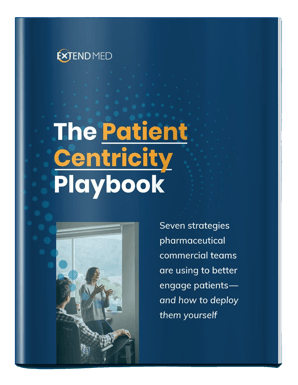The term “KOL engagement” conjures a number of definitions depending on whom you ask.
Traditionally, it has referred to gathering insights from a relatively small group of HCP thought leaders within a given therapeutic area, who guide their peers in researching, developing products, entering markets, and similar activities.
Recently, however, as pharma and healthcare teams pursue a more patient-centric healthcare model and embrace new capabilities unlocked by technology, the “key opinion leader” is no longer the only stakeholder having a say.
Pharma teams are bringing more, and more kinds of stakeholders to the table. Given this evolution, it’s time to refresh that definition with one that’s more inclusive and expansive—one that captures the larger “ecosystem” of stakeholders, including patients, payers, care teams, and pharmacists.
This guide presents that definition and describes the evolution from “KOL engagement” to “stakeholder engagement.” It also explores engagement challenges and provides some practical strategies for mitigating them.
Use this guide to learn how to modernize your engagement program and articulate your need for a partner who can give you the tools and strategies to be successful.
📄 If you’re interested in the other dimensions of KOL/stakeholder management, read our companion guide, KOL Management in Pharma: A Complete Guide.
This guide covers:
- What “KOL engagement” means today
- Why it’s important
- Common challenges and solutions with tactical examples, including:
- The results of effective engagement
Before we jump in
Pharma teams responsible for engaging KOLs and other healthcare stakeholders make their work ultra-productive when they use a technology platform purpose-built to facilitate outreach, host synchronous and asynchronous engagements, and handle administrative tasks like contracting and Sunshine reporting—all from a single place.
With more pharma teams using these platforms, KOLs are coming to expect the conveniences they bring. And without such a tool, orchestrating a modern engagement program can be incredibly burdensome and time-consuming—all while producing insights with less fidelity and business value.
Pharma teams partnering with ExtendMed maximize their KOL interactions at a fraction of the cost of traditional approaches. Read a few of those success stories here and talk to us when your team is interested in exploring a modern engagement solution.

📄 Free White Paper
The Patient Centricity Playbook
Seven strategies pharmaceutical commercial teams are using to better engage patients—and how to deploy them yourself
What does KOL engagement mean in 2025?
We picked at this definition in the introduction, but let’s unpack it a little further. Traditionally, “KOL engagement” has had a narrow definition: forming relationships with expert, high-profile clinicians and healthcare professionals in a given therapeutic area to gain their input and insight in service of a specific goal.
The term “key opinion leader” signals a certain status: those recognized as thought leaders in their space and whose guidance is actively sought by peers. A prime example would be a principal investigator in a clinical trial.
Pharma teams often leverage KOLs’ expertise for many core business activities, including:
- Designing and orchestrating a clinical trial to reach certain endpoints
- Planning how to broaden treatment access to patients
- Understanding how to expand current markets and break into new ones
- Developing commercialization strategies
Today, however, the term “KOL” limits what can (and often should) be a much larger scope of engagement. Modern engagement tools enable pharma teams to form relationships with a much larger array of stakeholders beyond a single, narrow group of key opinion leaders. When they do this, they get far better insights and ultimately make more informed decisions.
Where pharma teams were once forced to focus solely on high-priority KOLs because there was only so much human and technical bandwidth to do so, today’s engagement tools have dissolved those limitations. These tools allow even small medical affairs and commercial teams to scale their engagement program to match those of a larger, better-resourced company and gather insights from many people.
In short, “KOL engagement” has evolved to “healthcare engagement.” And as we’ve seen firsthand as the technical and strategic facilitator that pharma teams and their partners lean on to capitalize on this evolution, the feedback generated from a multifaceted stakeholder engagement program delivers a whole new level of clarity and richness that translates directly into measurable business value.
“‘KOL engagement’ should be more broadly defined to include other stakeholders; not just the people who are defining your clinical studies, but also the healthcare providers who are engaged from a care team perspective, the nursing community, pharmacists, and others.
If you're dealing with a product that is infused, for example, there’s likely a whole group of infusion specialists who are stakeholders in the process. They’re aware of challenges and obstacles, and can offer insights that will really help advance your product in the long run.”

— Amy Ravi, CEO, ExtendMed
Given this recent evolution, a more modern definition of “stakeholder engagement” might be: engaging the full spectrum of stakeholders, including various HCPs, patients, and payers, to solicit feedback in person and online, synchronously or asynchronously.
While we’ll carry the idea of this evolution from “KOL” to “stakeholder” forward throughout this guide, we’ll continue to refer to “KOL engagement” since it continues to be the term used most often when referencing an engagement program.
Why is KOL engagement important?
While KOLs aren’t the only audience pharma teams engage anymore, their importance has not diminished at all.
A KOL’s expertise and power to influence will always be invaluable—and their position as credible leaders continues to be critical to strengthening a company’s position among other stakeholders who look to them for guidance.
The best pharma teams continue to skillfully parlay their KOLs’ credibility into their own brand to mobilize stakeholders throughout the product lifecycle, drive market adoption, and accomplish other goals. But now let’s broaden this question to consider the importance of stakeholder engagement. Why is it important to evolve from KOL-only engagement to bring in the voices of more stakeholders?
In short, stakeholder engagement enables you to gather richer, more diverse, and ultimately more valuable insights.
Where KOL-only engagement tends to over-index the perspectives of KOLs, stakeholder engagement finally brings other groups to the table. It provides a more balanced set of opinions, feedback, and insights that lead to better decision-making.
“Pharma teams that work with us to apply a systems approach to their engagement program not only unlock efficiencies, but actually expand their inputs. They’re able to deliver a product that hits the mark for all the stakeholders rather than a small, very influential group of them.”

— Amy Ravi, CEO, ExtendMed
By having that broader array of healthcare stakeholders engaged in discussion—perhaps a group of patients and frontline care coordinators in addition to clinician KOLs—pharma teams can shape critical aspects of their business to cater to everyone. They can form strong relationships with a more diverse stakeholder group to gain insights into everyone’s priorities and offer the best ways to influence and reach each group.
Speaking from experience, we know pharma teams are always looking for ways to add value to their stakeholders. Today’s engagement tools, including ExtendMed’s Health Expert Connect™, take all things that make stakeholder relationships strong and amplify them even more.
For example:
➤ Acknowledging a stakeholder’s commitment and input is critical for keeping and growing a relationship with them. But that’s often hard to do.
ExtendMed supports pharma teams with a convenient system to give someone’s input the recognition it deserves—allowing others to share reactions and elevate great ideas while challenging those without a basis.
➤ Building trust is another essential element of a strong stakeholder relationship that can be a struggle without a tool to do so.
ExtendMed enables pharma teams to provide critical information to stakeholders upfront and take questions or address concerns proactively—immediately fostering an environment that makes stakeholders comfortable and, therefore, motivated to participate meaningfully.
➤ One of the most difficult but most essential dimensions of stakeholder engagement is maintaining relationships with those whose opinions of a product are negative, and, therefore, extremely important to interrogate and understand deeply.
In these situations, the value of a platform that makes it easy for these stakeholders to engage—rather than one that inserts friction into the engagement—can go a long way in keeping relationships that aren’t always positive.
The challenges of effective KOL engagement
The benefit of engaging KOLs and other stakeholders in a cost-effective, timely way, and incorporating a range of viewpoints is obvious: better products, increased compliance, and happier, healthier patients.
Achieving these goals, however, is often less straightforward.
Many companies find it challenging to engage with stakeholders to gather informative insights as frequently as they would like, and when they do, it’s often in settings that are costly to arrange and difficult to coordinate, with information silos adding another layer of difficulty in consolidating insights and aligning teams in different departments who may each be contributing to the engagement strategy.
We’ve pulled out some of the top engagement challenges we encounter and solve to clearly position today’s engagement tools as a multi-faceted solution to them.
Challenge #1: Volume of work and scalability
Engaging one stakeholder community is difficult enough. The prospect of engaging with multiple communities in line with our revised definition of KOL engagement may feel daunting. Without an efficient mechanism for identifying and contracting not one but multiple stakeholder communities is an overwhelming amount of work.
Solution
Today, solutions like ExtendMed’s help you systematize this process at scale within a set timeframe, allowing you to gather insights from multiple viewpoints.
💡 Example engagement activity: Message testing
Consider a tactical application of ExtendMed’s platform:
A company wishes to work with a group of advisors through a virtual, synchronous advisory board before a product launch to test whether its messaging, discussion guides, and study result slides are hitting their mark just before introducing a new brand to market.
- First, the company can use the system to engage a smaller group of advisors, many of whom have already been involved in clinical studies as principal investigators and will ultimately be the ones to introduce their peers to the new product.
- Second, the advisor insights are both captured and distributed by the same system to internal legal and compliance teams to review this data and contribute their ideas about how the messaging should be delivered to the stakeholders.
- Third, within the system, these ideas are presented to a broader set of stakeholders beyond the small group that you started with. These people can be engaged asynchronously with surveys, discussion boards, and resource sharing. Not only can they engage with other participants, but the company can respond to their questions and concerns in real time with replies and additional resources.
In this way, multiple KOL groups and internal teams can be involved in a process without missing a beat. The company, in turn, has the opportunity to shift its strategy in real time in response to inputs from multiple stakeholder groups that help it refine its messaging to address concerns before launch.
Challenge #2: Sharing information across teams
Another common challenge for pharma teams is efficiently sharing insights internally across teams.
Without a systematic mechanism for knowledge management and transfer within an organization that allows everyone to learn from and benefit from these insights, even the most helpful insights are relatively unactionable.
Solution
A company’s engagement strategy generally involves multiple teams. For example, you might have a tactical plan for your congress presence that involves a satellite symposium, product theater, and poster sessions. At the same time, another group might be thinking about advancing brand awareness within a certain market, and maybe that group is doing a series of ads, webcasts, or promotional education.
For everything to go well, those two groups must meet and share information, as their target audiences overlap. If they can align, this enables one team to be aware of questions or concerns the other team uncovered in their engagement so appropriate follow-ups can be made.
A single system that allows you to both capture insights from multiple engagements and share these across a broader team, whether that’s through a transcript, executive summary, or slide deck makes sharing across teams efficiently and conveniently.
💡 Example engagement activity: A “mad lib” messaging exercise
Imagine a pharmaceutical commercial team that wants to be able to structure clinical messaging around a clinical analogy.
- First, they create an asynchronous “mad lib” exercise that asks their advisory group of clinicians to “fill in the phrase” with conditions those clinicians treat that are analogous to treating another particular condition.
- By identifying the specific, word-for-word messaging from the clinicians, the pharma team can better educate itself on how to craft its messaging.
- But this exercise also helps clinicians work out more precise messaging in their own heads—in this case, clarifying how they can more clearly communicate why a given treatment would be appropriate for a patient, to that patient.
“Not only do these kinds of mad lib-style exercises help a provider refine their own messaging, but the fact that it’s peer-based makes them productive knowledge-sharing experiences, too. Very often, someone will have found a really excellent way to convey a point to patients, so these engagements let other providers borrow those best practices from one another and spread those learnings around.”

— Amy Ravi, CEO, ExtendMed
This engagement activity can be executed asynchronously via ExtendMed’s online discussion board, giving clinicians a user-friendly way to fill in the mad lib phrases, see each other’s input, and engage in additional discussion.
Challenge #3: Frequency, timing, and consistency of engagements
Often, pharma teams don’t have the opportunity to facilitate frequent, consistent interactions with KOLs—much less other stakeholders.
Instead, they save up their questions for a single (often in-person) ad board, often limited to a single session with only a few hours to satisfy a year’s worth of feedback needs.
While participating in, for example, an annual congress is beneficial, it is not particularly helpful when a team wants time-sensitive feedback on new messaging, such as an interactive visual aid.
Solution
Technology solutions are game changers when it comes to ensuring consistent, easier, and more frequent interactions that are still cost-effective.
Rather than investing time and money in arranging an annual in-person interaction that lasts several hours, companies have the opportunity to divide that time into shorter, more frequent virtual engagements that are easier for stakeholders in different time zones to attend.
This provides the added benefit of being able to ask timely questions in real time, either through asynchronous discussion boards or monthly meetings, allowing pharma companies to get quick feedback for time-sensitive projects as the need arises.
“Maybe you participate in a congress, and there's an interpretation of a new clinical study, and you want input on that. Maybe you're now releasing an interactive visual aid, and you really want to know if you’ve hit the mark: are you really getting the messaging across loud and clear to your target audience? And so, maybe there's a way to quickly gather that from a smaller group of your cohorts.”

— Amy Ravi, CEO, ExtendMed
Moreover, the system itself has already gone through a legal and regulatory process, the emails are templatized and, thus are already approved.
This means that engaging stakeholders asynchronously with Health Expert Connect™ is as simple as clicking a button to send a message to the entire community. Contracting is already set up to account for multiple engagements over the course of a year, so there is no need to re-contract every time you want to have an engagement.
Managing all these logistical elements at the beginning increases efficiency overall. In a digital world, there's no reason to adhere to old-fashioned and inflexible styles of engagement. Instead, follow-up questions can be asked as they come up organically, enriching the insights and developing better rapport with KOLs.
“There's something very important from the healthcare provider’s perspective or from the patient advocate’s perspective about feeling consulted in a more regular manner. It conveys that they are valuable participants in that treatment paradigm. And so, having the opportunity to engage more frequently, we find that most people don't say they're too busy. On the contrary, they say, ‘could you involve us more? We have a lot of insights to share, and we would like to be consulted with more frequency.’”

— Amy Ravi, CEO, ExtendMed
💡Example engagement activity: Synchronous patient Q&A
Another engagement activity we executed was in the area of patient advocacy. A pharma team was targeting a new, first-to-market therapy for cardiovascular disease and worked with us to run a series of patient advisory board meetings to surface notable concerns around the treatment so obstacles could be addressed.
Partnering with the pharma team, we conducted a synchronous advisory board engagement with 10 patient advocates who were asked a series of structured questions by a moderator. The moderator walked the patients through the parameters for treatment eligibility and solicited their reactions.
- What did they think about it?
- What would need to happen for them to consider this treatment?
- Were there any obstacles they saw in the clinical guidelines that would prevent them from proceeding with a treatment plan?
- How would this new treatment compare to other treatments that you’ve used to address this chronic condition?
During these ad boards, patients brought up a real concern: whether the number of echocardiograms required as a precursor to starting this particular treatment would be covered by insurance. Our ad board unveiled an important obstacle for this treatment that must be overcome before launch.
The moderator addressed which patients would be eligible for treatment, the parameters for eligibility, and gathered reactions concerning what actions would need to be taken for patients to proceed with this treatment plan.
💡Another example engagement activity: Identifying patients ideal for a treatment
As a possible standalone or add-on exercise to the example above, another engagement could be aimed at building an ideal patient persona for a given treatment.
- That could start with an initial synchronous exercise bringing together healthcare stakeholders from different backgrounds. Perhaps that includes someone from a smaller clinical, another practicing at an academic medical center, etc.
- In this case, you could discuss the characteristics that define an ideal patient for this treatment.
- After having the discussion, clinicians can identify some differences in each other’s populations.
- Next, they can move to an exercise where everyone reads a particular article and then takes a questionnaire that asks them to develop a hypothetical patient case from their population to more precisely tease out the nuances of addressing, for example, geriatric patients in rural communities with the same disease as an urban patient on Medicaid.
“There are so many opportunities to use surveys, host synchronous meetings, hold whiteboarding exercises, and work in small groups to identify what ideal patients look like, and take that a step further to do some further education, have some overtime discussions, and see if, for example, your clinicians can identify a patient that meets the criteria out of your patient population and submit that through a survey.”

— Amy Ravi, CEO, ExtendMed
Challenge #4: Building trust
When information about products shared with HCPs comes through portals from a single, biased source, it can be difficult for companies to build trust with these individuals.
Solution
When companies open channels for two-way communication, providing information and actively seeking feedback from KOLs and other healthcare stakeholders, this can help build trust and establish a company as a more credible source. Moreover, when stakeholders have the opportunity to interact with one another regularly and provide feedback as a group, they can learn from each other.
Not only asking for opinions from one another but allowing them to have peer interactions over an extended period of time helps establish rapport between KOLs and the company while fostering real relationships between KOLs. This ultimately can result in richer conversations and more, better insights.
The cumulative effect, or equity, has long-term benefits in helping our clients gain a competitive advantage.
“There is a real opportunity for peers to engage and to bring one another along. One HCP may be doing something very different in practice at a small, community-based hospital than what another is doing at a large, urban-network hospital that's academic.
They have the opportunity to share their practice, how they are treating patients, and what kinds of patients they see, and learn from one another. If they have more frequent opportunities to do that, they really can bring someone along in the process and say, 10,000 hours of practice equals mastery, but now you're not putting 10,000 hours into a single engagement.
You're allowing the constituent, your stakeholder, to engage over time, to digest that information, and to ask further questions to build on it.”

— Amy Ravi, CEO, ExtendMed
The results of effective KOL engagement
With a systems approach, companies can engage more people, more efficiently, cost-effectively, and in a more timely manner. A system for engagement enables them to expand their inputs in gathering insights to deliver products that hit the mark for all stakeholders more often.
Through this process, the company can become more aware of stakeholder challenges and obstacles and incorporate insights that help advance its products in the long run.
Not only that, but when all the major players who could benefit from the product—the patients taking it, HCPs prescribing it, and payers covering it—have been kept in the loop about the product since early on in the process and already understand it, they may well feel more comfortable complying with treatment, prescribing it, and paying for it. This contributes to a sense of comfort from all parties and can have a real effect on ROI.
“I think it's really important to understand the obstacles that may exist in other frameworks. So if you're just engaging an academic clinician who's involved at a top-tier network hospital, they may have access to equipment, like specialty scanning devices, that the community hospital in the middle of a smaller town may not be able to access.
So that community clinicians who are treating the same disease wouldn't know how to proceed in the pathway to getting the patient the treatment that he or she needs.
There are legitimate differences depending on the organization and community that you're a part of, the construct of the insurance, and the formularies that are accessible to you and to your patients. That really affects how you can deliver treatment and make use of a specific product.
So understanding all those perspectives really helps you to broaden your impact with your products in diverse communities with diverse insurance plans, formularies, and patient needs.”

— Amy Ravi, CEO, ExtendMed
How ExtendMed helps companies engage KOLs—and other healthcare stakeholders—better
ExtendMed's Health Expert Connect™ allows KOLs and other healthcare stakeholders to engage in lively and productive conversations with their peers via asynchronous virtual discussion boards, journal clubs, and other online activities when it's convenient for their schedules.
ExtendMed differentiates itself from similar platforms by focusing on both synchronous and asynchronous interactions and engagements, from curated, synchronous live or virtual meetings with interactive features to asynchronous surveys and discussion boards. This combined approach to engagement offers some wholly new capabilities that teams find both convenient and extremely valuable.
Visit pages.extendmed.com/solutions for a quick look at our solutions, and how we empower teams to have richer engagements with each of their stakeholders. Want to get in touch with questions or schedule a free platform demo? Contact us.
📄 Want some more food for thought? Check out our free white paper below and get seven strategies pharmaceutical commercial teams are using to better engage patients—and tips on how to deploy them yourself.

📄 Free White Paper
The Patient Centricity Playbook
Seven strategies pharmaceutical commercial teams are using to better engage patients—and how to deploy them yourself



